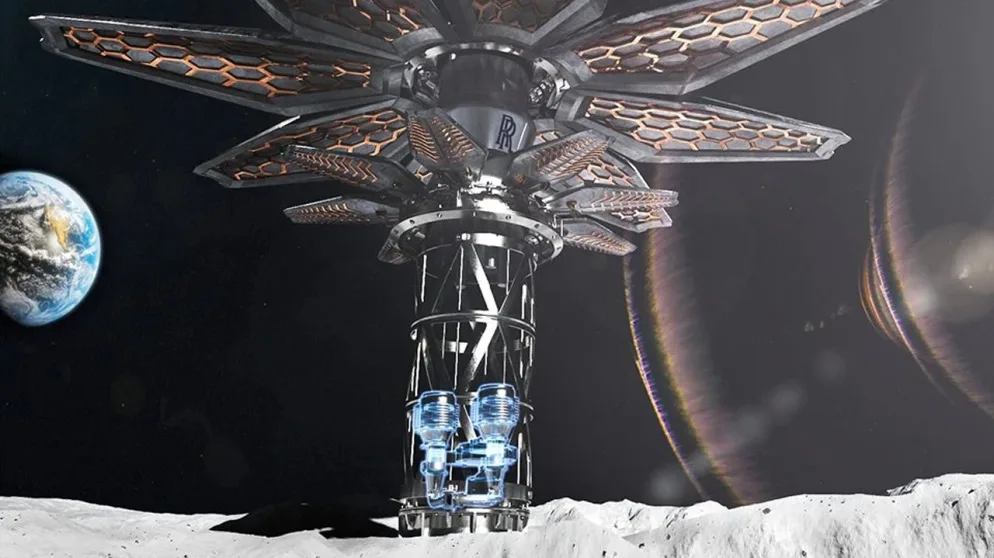Rolls-Royce Unveils a Mini Nuclear Reactor for Lunar Missions: Achieving Lunar Power Goals
The race to the moon has just advanced significantly with the introduction by Rolls-Royce of a miniaturized nuclear reactor that will supply power to future lunar outposts.
The “Micro-Reactor,” an innovative concept that provides a dependable and environmentally friendly energy supply for lunar settlements, has the potential to facilitate the establishment of a permanent human presence on our celestial neighbour.
A minuscule powerhouse by Rolls-Royce:
The Micro-Reactor, which measures a mere 3.3 feet (1 meter) in width and 10 feet (3 meters) in length, is a marvel of engineering. Given the logistical difficulties involved in space exploration, the moon’s compact design makes transportability and deployment easier.
Although it is compact, the micro-reactor is exceptionally potent. Its thermal energy output of 50 megawatts is sufficient to supply electricity to a town of average size on the planet.
This energy can be converted to electricity to power lunar operations, including mining, habitation, and research. In pursuit of a sustainable future, nuclear power.
Read More
Meta’s Ray-Ban Face cameras work well with smart eyewear
In contrast to the lunar surface, where limited daylight and feeble solar winds render conventional solar and wind energy sources unreliable, the micro-reactor provides a consistent and dependable energy supply.
Ensuring a steady supply of power is imperative for sustained lunar settlements, as it powers life support systems, scientific investigations, and resource extraction.
In addition, nuclear energy provides a sustainable and environmentally friendly energy alternative. In contrast to fossil fuels, which contribute to environmental damage and greenhouse gas emissions, the micro-reactor operates without generating hazardous contaminants.
Consequently, it is an essential element in the establishment of an environmentally conscious and sustainable lunar presence.
Technical Obstacles and Safety Issues for Rolls-Royce:
Although the micro-reactor shows a lot of promise for lunar exploration, there are significant technical barriers that prevent its actualization. The intense radiation environment on the moon, which could damage reactor components, is a significant concern.
Rolls-Royce is developing thermal pipes and shielding materials that can withstand the harsh lunar environment in order to mitigate this risk.
Further impediments that must be surmounted concern the secure disposal and management of nuclear waste aboard the moon. Rolls-Royce is currently investigating a range of alternatives, such as relocating the refuse to Earth for secure disposal via launch or burial.
Collaboration and Prospects for the Future:
Rolls-Royce is not the only company striving to create lunar energy solutions. The organization, commercial companies, and international space agencies are working together to develop the micro-reactor design and overcome technological challenges.
The micro-reactor is anticipated to be deployed on the moon by the early 2030s. Achieving this lofty objective necessitates committed cooperation and financial commitment from both private and public organizations.
Applications for Space Exploration Beyond the Moon:
Microreactor technology transcends the vacuum environment of outer space. The potential of its compact design and high energy output extends to powering additional space missions, such as the investigation of Mars and further beyond.
As it continues to advance, this technology has the potential to fundamentally transform space exploration by furnishing interplanetary outposts and deep space travel with a dependable and sustainable energy source.
In conclusion:
In the history of space exploration, Rolls-Royce developed the Micro-Reactor, which is a significant accomplishment. This cutting-edge technology could power future lunar settlements, revolutionizing space travel and opening the door for a sustained human presence beyond Earth.
Despite challenges, the microreactor shows a future where nuclear energy powers space exploration.
Share this content:

